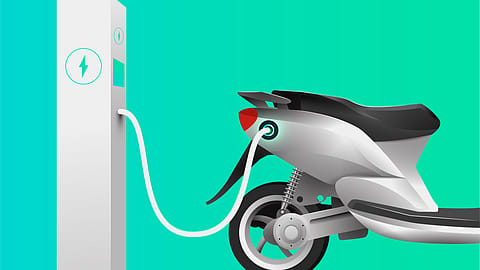Can India's EV lenders handle the rare earth metal blues?
As rare earths disrupt EV supply, e-2W lenders such as Credifin are betting on demand resilience

On a recent visit to Nepal, I was struck by the number of electric vehicles conquering the treacherous roads–from two-wheelers to full-sized vans of brands I hadn't heard of before. Just as surprising was the sight of EV charging stations tucked in between tea stalls and grocery stores, that ironically sold petrol in plastic water bottles. The country's electric mobility is an example of how EVs fit into daily life when affordability, accessibility, and infrastructure come together. A major driver of this transition has been Chinese automakers and investments, which have made electric vehicles mainstream in a region that has been considered geographically challenging.
Back home in India, however, the EV growth faces a new jolt–one that strikes the very heart of how an EV is built: it's motors. As China tightens its grip over exports on rare earth minerals, a key input in building the permanent magnet synchronous motors (PMSMs), the part that is the backbone of most EVs, supply chains are feeling the stress. According to a recent Crisil report, not a single export clearance for rare earth magnets has come through since April 2025 from Beijing. If this goes on, many automakers fear that inventories will run dry by July, and even if these parts make up 1 kg to 1.5 kg of the total vehicle weight and contribute only 5% of the vehicle cost, their absence could stall production lines across the country.
The Crisil report also stated that this trend could derail the projected 27% growth in electric 2-wheelers and 3-wheelers, while disrupting new EV launches. In FY2025, electric two-wheelers strengthened their lead in India’s EV market, accounting for 58.5% of total EV sales with 1.14 million units sold, rising by 21% year-on-year (YoY) and surpassing the million sales milestone. Established players such as TVS and Bajaj Auto saw strong gains, with Bajaj more than doubling its sales.
But China's grip over rare earth elements would create a hurdle for this EV two-wheeler growth. This crisis could be mitigated to an extent through different approach and alternatives to rare earth elements. "Automakers are actively engaging with alternative suppliers in countries such as Vietnam, Indonesia, Japan, Australia, and the US, while also optimising existing inventories. With applications across EVs and ICE vehicles, a prolonged supply squeeze could disrupt production of PVs and 2Ws, making this low-cost component a potential high-impact bottleneck for the sector," states Poonam Upadhyay, Director of Crisil Ratings.
In the middle of this uncertain landscape, non-banking financial companies (NBFCs)—especially those funding the EV boom, are navigating the crisis from a different vantage point. Credifin, a Jalandhar-based NBFC with over 65% of its ₹350 crore loan book in EVs, with its CEO Shalya Gupta remaining surprisingly optimistic.
“Rare earths are a chokepoint, yes—but not a dead end,” Gupta says. He sees opportunity in agility to adapt. Credifin’s borrowers aren’t buying EVs as lifestyle products—they’re buying them as tools of livelihood. “Incomes are built on these vehicles. If supply slows, it doesn’t mean demand disappears. It just shifts or waits.”
That demand-side resilience is backed by a risk-aware lending model. Credifin closely evaluates the bill of materials of multiple OEMs, only financing products that deliver sustainable value, particularly in the ₹55,000–₹75,000 range. Gupta describes his strategy as active filtration - if margins are inflated or the supply chain looks volatile, the loan doesn’t go through. “We’re not in the business of chasing volumes,” he says. “We fund products that make economic sense—down to the last nut and bolt.”
Recommended Stories
While manufacturers may struggle with upstream bottlenecks, NBFCs such as Credifin still retain flexibility in what they choose to finance. Gupta too notes that supply will likely “reroute" through Dubai, Hong Kong, or Mauritius, as it has in past disruptions, citing the lithium price crash that happened last year.
If component shortages persist beyond July or if prices make EVs unviable for the ₹10,000–₹12,000 EMI customer, lenders may be forced to pause or pivot. Gupta says that such moments of crisis should be seen as an opportunity. "UPI (Unified Payments Interface) was introduced in 2016 itself, but it took a crisis like the COVID-19 pandemic to bolster the usage. We are 10-15 years ahead in terms of digitisation because we adapted to a crisis. Similarly, this situation should pivot our country towards self-sustenance," he adds.


